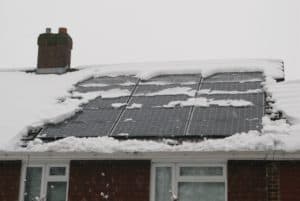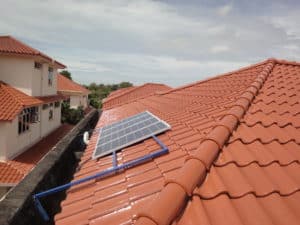Ditch Your Misconceptions: Why the Solar Panels on Your Arden-Arcade Home Still Produce Energy in Fall
![]() Arden-Arcade is home to some of Sacramento’s prettiest communities, including Sierra Oaks, Arden Park, and the neighborhoods around the Del Paso Country Club. The area gets an average of 265 sunny days a year, but there are still a lot of concerns I seem to hear over and over again about using solar power. What happens on the 100 days in Arden-Arcade that aren’t sunny? Is there a time of year when my photovoltaic solar panels will be useless? My answer is simple—no.
Arden-Arcade is home to some of Sacramento’s prettiest communities, including Sierra Oaks, Arden Park, and the neighborhoods around the Del Paso Country Club. The area gets an average of 265 sunny days a year, but there are still a lot of concerns I seem to hear over and over again about using solar power. What happens on the 100 days in Arden-Arcade that aren’t sunny? Is there a time of year when my photovoltaic solar panels will be useless? My answer is simple—no.
Believing that solar panels don’t function in cloudy fall weather is a common misconception, even in our sun-drenched state. But, with California’s energy mandates making the use of solar power more incentivized, solar energy is becoming more and more appealing to homeowners in our local community. Depending on the makeup of your Arden-Arcade home, you could be saving money by going green and clean. And that’s cash you can take with you the next time you go shopping at Arden Fair or Country Club Plaza. I know that switching your home to solar takes a lot of research—just don’t let fears about your solar panel’s seasonal energy output be what holds you back.
Misconception #1: Solar Panels Aren’t Effective in Cold Weather
One of the most common reasons why homeowners don’t explore solar power is because they live in a place with distinct fall and winter seasons. But, I even hear this concern in our area, where fall and winter are nowhere near as harsh as other parts of the country. Homeowners worry that our rare frosts, and our even rarer snows, will hurt solar panels. But this is only true if a massive amount of snow covers a photovoltaic solar panel.

Snow melting off of solar panels | Photo via flick’r user julian
If you’re considering solar energy for your home in Arden-Arcade, be assured that heavy snow is unlikely. Over the past 100 years, the most snow measured in our area was on February 5, 1976, when weather experts measured a whopping 2 inches at the Sacramento airport. That is simply not enough to hinder the effectiveness of, or damage, photovoltaic solar panels.
Besides, the dark surfaces of photovoltaic solar panels make frost or snow melt quickly—they have darkly colored surfaces designed to draw in the sun’s rays. They also feature very sleek, angled surfaces. If snow or frost does settle on your panels, they will quickly gather enough heat from the sun to melt the precipitation so it slides right off its slippery surfaces.
Misconception #2: Solar Energy Doesn’t Work When It’s Cloudy

Solar panels on a cloudy California day | Photo via Flick’r user Marufish
I hear a lot of concern about solar energy being impossible to produce on our rare cloudy days. This is another false misconception. As anyone who ever listened to his or her mom will tell you, you can still get burned by the sun on a cloudy day. For photovoltaic solar panels to generate energy, the only thing they need is UV light—which just so happens to be able to seep through clouds.
In fact, the world-leader in solar power is Germany, a country that has just about as much sunlight as Alaska, but the fact that solar panels convert energy using that cloud-penetrating UV light means Germany generates an enormous amount of solar power anyway. What does this mean for your home in Arden-Arcade? Solar power will be effective, even on our occasional cloudy fall days.
Misconception #3: The Architecture of My Home Doesn’t Create Good Conditions for Solar Power.
People seem to think that the architecture of certain houses means they can’t benefit from solar power. Actually, there’s some truth to this one—there are many factors associated with whether solar energy is right for a home. These factors include:
- Location and Position of the Home: Solar panels work best when there is room for them on the south-facing side of a home. This is true in all seasons, because regardless of whether it is spring or fall, this side of your house will soak up the most sunlight.
- The Surrounding Trees: Like all of the Sacramento-area, Arden-Arcade has quite a few trees. Unlike clouds, trees create shade which does block UV light, and ultimately renders solar panels ineffective. This is, almost ironically, more of an issue in spring and summer when the sun is out—but so are the leaves. If your home has an abundance of deciduous trees, you may actually see an improvement in your energy output in the cooler seasons.
- Backyard Activities: Solar panels can be fairly vulnerable to breakage. You don’t want to install them in a place where a stray pass during a touch football game is likely to land. Especially if your backyard is positioned on the south side of your home, you will want to consider your outdoor activity level—although I would argue this is more of an issue in the spring and summer, when your kids may be especially active outside, than in the fall and winter months.
This delicate balance of architecture versus efficiency is why I always suggest that homeowners who are considering solar power give their local installation experts a call to see if solar energy makes sense for their home. In fact, there’s no better time than the fall season to consider a solar consultation, when all of these misconceptions reduce the demand. But, whatever you decide, don’t let concern about fall and winter weather be what stands in your way.
Don’t let cloudy days stop you from exploring whether photovoltaic solar panels are right for your home. Contact your local solar company and ask for an assessment.

